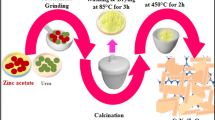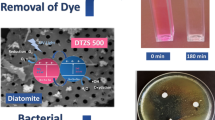Abstract
Zeolite imidazole skeleton (ZIF-8) is a promising option for self-cleaning of building exterior walls due to its large specific surface area, high antibacterial activity and low biotoxicity. However, it suffers from low antibacterial efficiency and yield under visible light irradiation. To address the issues, we developed the photocatalytic materials T-ZIF-8-TDI (thermally treated-ZIF-8-toluene 2,4-diisocyanate) by modifying ZIF-8 with thermal oxygen sensitization and chemical bonding. The results show that the yield of T-ZIF-8-TDI photocatalytic antibacterial agent is increased to 11.5 times of that of T-ZIF-8, while maintaining the crystal structure of T-ZIF-8 and thermal stability up to 60 °C. Furthermore, T-ZIF-8-TDI exhibits extended optical response range to the near-infrared region, significantly narrowed band gap, improved photogenerated electron–hole separation efficiency, reduced recombination rate, and excellent photocatalytic performance. When the concentration of antibacterial agent is 600 mg·L−1, the antibacterial rate of Escherichia coli (E. coli) reaches 99.99% irradiated by visible light for 30 min, and when the concentration of antibacterial agent is 200 mg·L−1, the antibacterial rate of Staphylococcus aureus (S. aureus) reaches 99.99% irradiated by visible light for 25 min. We also analyzed the reasons in detail from the aspects of bacterial species and antibacterial mechanism, and proposed the antibacterial mechanism of ·O2− and h+ as the main active species. These findings suggest that T-ZIF-8-TDI photocatalytic antibacterial agent has potential for use in self-cleaning of building exterior walls.
Graphical abstract

摘要
沸石咪唑骨架 (ZIF-8)具有比表面积大、抗菌活性高、生物毒性低等特性, 是一种极具前景的建筑外墙自洁净材料。但在可见光照射下, 其抗菌效率和产率较低。为解决这一问题, 本论文采用热氧敏化和化学键合法对ZIF-8进行改性, 研制出光催化材料T-ZIF-8-TDI。结果表明, T-ZIF-8-TDI光催化抗菌剂的产率比T-ZIF-8提高了11.5倍, 同时保持了T-ZIF-8的晶体结构, 60 °C 前其热性能保持稳定; T-ZIF-8-TDI的光响应范围扩展到近红外光区, 带隙明显缩小, 光生电子空穴分离效率大幅提高, 复合速率显著降低; 抗菌剂浓度为600 mg·L−1时, 可见光照射30 min, 对大肠杆菌的抗菌率达99.99%, 抗菌剂浓度为200 mg·L−1时, 可见光照射30 min, 对金黄色葡萄球菌的抗菌率达99.99%。我们从细菌种类和抗菌机理等方面详细分析了原因, 提出·O2−和h+为主要活性物种的抗菌机制。上述结果表明, T-ZIF-8-TDI光催化抗菌剂在建筑外墙自清洁方面具有潜在应用.








Similar content being viewed by others
References
Jin WH, Song P, Wu YJ, Tao YG, Yang K, Gui L, Zhang WW, Ge F. Biofilm microenvironment-mediated MoS2 nanoplatform with its photothermal/photodynamic synergistic antibacterial molecular mechanism and wound healing study. ACS Biomater Sci Eng. 2022;8:4274. https://doi.org/10.1021/acsbiomaterials.2c00856.
Yang RG, Fu YM, Wang HN, Zhang DP, Zhou Z, Cheng YZ, Meng X, He YO, Su ZM. ZIF-8/covalent organic framework for enhanced CO2 photocatalytic reduction in gas-solid system. Chem Eng J. 2022;450:138040. https://doi.org/10.1016/j.cej.2022.138040.
Gowriboy N, Kalaivizhi R, Ganesh MR, Aswathy KA. Development of thin film polymer nanocomposite membrane (ZIF-8@PSf/CS) for removal of textile pollutant and evaluating the effect of water samples on human monocytic cell lines (THP-1) using flow cytometer. J Clean Prod. 2022;377:134399. https://doi.org/10.1016/j.jclepro.2022.134399.
Guo JD, Jia HS, Zhang AQ, Pei Z, Luo M, Xue BJ, Shen QQ, Liu XG, Xu BS. MIL-100 (Fe) with mix-valence coordinatively unsaturated metal site as Fenton-like catalyst for efficiently removing tetracycline hydrochloride: boosting Fe(III)/Fe(II) cycle by photoreduction. Sep Purif Technol. 2021;262:118334. https://doi.org/10.1016/j.seppur.2021.118334.
Qu HH, Wang C, Guo YX, Zhao ZY, Qiao L, Yang JB, Wu HX, Li QS, Dong A. Electrospun N-halamine/ZnO-based platform eradicates bacteria through multimodal antimicrobial mechanism of action. Rare Met. 2023;42(1):222. https://doi.org/10.1007/s12598-022-02116-9.
Chen KX, Yang XQ, Qu Q, Wu T, Chen S, Li L. Inhibition of microbiologically influenced corrosion and biofouling of X70 carbon steels by near-superhydrophobic D-cysteine/Ag@ZIF-8 coatings. Corros Sci. 2022;208:110682. https://doi.org/10.1016/j.corsci.2022.110682.
Liu ZT, Yi YZ, Wang SJ, Dou HX, Fan Y, Tian LM, Zhao J, Ren LQ. Bio-inspired self-adaptive nanocomposite array: from non-antibiotic antibacterial actions to cell proliferation. ACS Nano. 2022;16:16549. https://doi.org/10.1021/acsnano.2c05980.
Zhang XL, Yuan N, Chen TX, Li BW, Wang QB. Fabrication of hydrangea-shaped Bi2WO6/ZIF-8 visible-light responsive photocatalysts for degradation of methylene blue. Chemosphere. 2022;307:135949. https://doi.org/10.1016/j.chemosphere.2022.135949.
Chai MZ, An MW, Zhang XY, Chu PK. In vitro and in vivo antibacterial activity of graphene oxide-modified porous TiO2 coatings under 808-nm light irradiation. Rare Met. 2022;41(2):540. https://doi.org/10.1007/s12598-021-01754-9.
Zhen P, Guo JD, Zhang Q, Jia HS, Xu BS. Research progress and application of metal-organic frameworks antibacterial composite materials and fibers. Acta Materiae Compositae Sinica. 2021;38:2396. https://doi.org/10.13801/j.cnki.fhclxb.20210507.001.
Yang H, Gu X, Li Y, Zhang K, Liu XH, Huang CY, Ren Y, Qi C, Cai KY. Multifunctional nanoreactors with nutrient consumption and ROS generation capabilities for antibacterial and skin repair. J Mater Chem B. 2022;10:8664. https://doi.org/10.1039/D2TB01436J.
Deng Q, Wang XC, Shao MQ, Fang L, Zhao XJ, Xu JJ, Wang X. Synthesis of chitosan-modified magnetic metal-organic framework and its adsorption of Congo red and antibacterial activity. Mesoporous Mater. 2022;342:112042. https://doi.org/10.1016/j.micromeso.2022.112042.
He ZH, Liu YH, Wang HF, Wang J, Pei XB, Chen JY, Zhang X, Zhu Z, Wan QB. Logic-based diagnostic and therapeutic nanoplatform with infection and inflammation monitoring and microenvironmental regulation accelerating wound repair. ACS Appl Mater Interfaces. 2022;14:39172. https://doi.org/10.1021/acsami.2c07732.
Li P, Li JZ, Feng X, Li J, Hao YC, Zhang JW, Wang H, Yin AX, Zhou JW, Ma XJ, Wang B. Metal-organic frameworks with photocatalytic bactericidal activity for integrated air cleaning. Nat Commun. 2019;10:2177. https://doi.org/10.1038/s41467-019-10218-9.
Hui SH, Liu QQ, Huang ZZ, Yang J, Liu YM, Jiang S. Gold nanoclusters-decorated zeolitic imidazolate frameworks with reactive oxygen species generation for photoenhanced antibacterial study. Bioconjugate Chem. 2020;31:2439. https://doi.org/10.1021/acs.bioconjchem.0c00485.
Ahanger AM, Kumar S, Arya A, Suryavanshi A, Kain D, Affiliation V. Synthesis and encapsulation of ajuga parviflora extract with zeolitic imidazolate framework-8 and their therapeutic action against G+ and G− drug-resistant bacteria. ACS Omega. 2022;7:1671. https://doi.org/10.1021/acsomega.1c03984.
Wang TQ, Wang YF, Sun MZ, Sun MZ, Aamir H, Wu H, Gu QF, Sik OY, Tsang DCW, Li JY, Yu JH, Shang J. Thermally treated zeolitic imidazolate framework-8 (ZIF-8) for visible light photocatalytic degradation of gaseous formaldehyde. Chem Sci. 2020;11:6670. https://doi.org/10.1039/D0SC01397H.
Pei Z, Fei PF, Zhang AQ, Guo JD, Hao JC, Dong HL, Shen QQ, Wei LQ, Jia HS, Xu BS. Thermal oxygen sensitization modification and its visible light catalytic antibacterial performance for ZIF-8. J Alloys Compd. 2022;904:164055. https://doi.org/10.1016/j.jallcom.2022.164055.
Lele BS, Russell AJ. Rational protein modification leading to resistance of enzymes to TiO2- UV irradiation-induced inactivation. Biomacromol. 2004;5(5):1947. https://doi.org/10.1021/bm049728o.
Noriyoshi M, Yoshiki C. Synthesis of π-conjugated poly(cyclodiborazane)s by organometallic polycondensation. Macromolecules. 2000;33(22):8146. https://doi.org/10.1021/ma991458s.
Jiang D, Xu Y, Wu D, Sun YH. Isocyanate-modified TiO2 visible-light-activated photocatalyst. Appl Cata B Environ. 2009;88:165. https://doi.org/10.1016/j.apcatb.2008.09.021.
Cui XL. Flat band potential of semiconductor electrodes. Chem. Bull. 2017;80:1160. https://doi.org/10.14159/j.cnki.0441-3776.2017.12.014.
Guo JD, Zhang AQ, Pei Z, Liu XG, Xu BS, Jia HS. IL-100 (Fe) with mix-valence coordinatively unsaturated metal site as Fenton-like catalyst for efficiently removing tetracycline hydrochloride: boosting Fe(III) / Fe(II) cycle by photoreduction. Sep Purif Technol. 2022;287:120568. https://doi.org/10.1016/j.seppur.2021.118334.
Ding YH, Zhang XL, Zhang N, Zhang JY, Zhang R, Liu YF, Fang YZ. A visible-light driven Bi2S3@ZIF-8 core–shell heterostructure and synergistic photocatalysis mechanism. Dalton Trans. 2018;47(3):684. https://doi.org/10.1039/C7DT03256K.
Qiu JH, Zhang XF, Zhang XG, Feng Y, Li YX, Yang LY, Lu HQ, Yao JF. Constructing Cd0.5Zn0.5S@ZIF-8 nanocomposites through self-assembly strategy to enhance Cr(VI) photocatalytic reduction. J Hazard Mater 2018;349:234. https://doi.org/10.1016/j.jhazmat.2018.02.009
Esken D, Turner S, Wiktor C, Kalidindi SB, Tendeloo GV, Fischer RA. GaN@ZIF-8: selective formation of fallium nitride quantum dots inside a zinc methylimidazolate framework. J Am Chem Soc. 2011;133:16370. https://doi.org/10.1021/ja207077u.
Xiong XY, Wang ZP, Zhang Y, Li ZH, Shi R, Zhang TR. Wettability controlled photocatalytic reactive oxygen generation and Klebsiella pneumoniae inactivation over triphase systems. Appl Catal B Environ. 2020;264:118518. https://doi.org/10.1016/j.apcatb.2019.118518.
Lin HX, Xu Y, Wang B, Li DS, Zhou TH, Zhang J. Postsynthetic modification of metal-organic frameworks for photocatalytic applications. Small Struct. 2022;3:2100176. https://doi.org/10.1002/sstr.202100176.
Yin WY, Feng JY, Lv T, Yan L, Zheng LR, Gu ZJ, Zhao YL. Functionalized nano-MoS2 with peroxidase catalytic and near-infrared photothermal activities for safe and synergetic wound antibacterial applications. ACS Nano. 2016;10:11000. https://doi.org/10.1021/acsnano.6b05810.
Huang MM, Zhuang H, Zhao JY, Wang JM, Wang WJ, Zhang JH. Differences in cellular damage induced by dielectric barrier discharge plasma between Salmonella Typhimurium and Staphylococcus aureus. Bioelectrochemistry. 2019;132:107445. https://doi.org/10.1016/j.bioelechem.2019.107445.
Wu YF, Zang Y, Liang X, Wang JJ, Jia HG, Miao FJ. Synthesis of high-performance conjugated microporous polymer/TiO2 photocatalytic antibacterial nanocomposites. Mater Sci Eng C 2021;126:112121. https://doi.org/10.1016/j.msec.2021.112121.
Acknowledgements
This research was financially supported by the Projects of the Research and Development Project of New Materials and Chemical Engineering Research Institute of Shanxi Zhejiang University (No. 2021SX-AT010), the National Natural Science Foundation of China (No. 21972103), Innovation and entrepreneurship training program for college students (No. 202110112012).
Author information
Authors and Affiliations
Corresponding authors
Ethics declarations
Conflict of interests
The authors declare that they have no conflict of interest.
Rights and permissions
Springer Nature or its licensor (e.g. a society or other partner) holds exclusive rights to this article under a publishing agreement with the author(s) or other rightsholder(s); author self-archiving of the accepted manuscript version of this article is solely governed by the terms of such publishing agreement and applicable law.
About this article
Cite this article
Zhang, YN., Pei, Z., Wang, ZH. et al. ZIF-8 modified by isocyanate as a photocatalytic antibacterial agent. Rare Met. 43, 2708–2718 (2024). https://doi.org/10.1007/s12598-023-02507-6
Received:
Revised:
Accepted:
Published:
Issue Date:
DOI: https://doi.org/10.1007/s12598-023-02507-6




